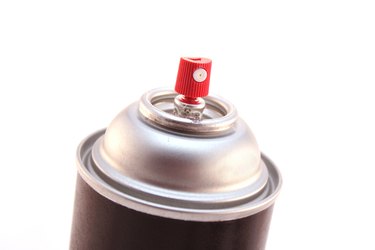Paint technology keeps improving year after year. A few decades ago, you couldn't find a paint that would adhere to plastic, but now you can it almost anywhere. Before you choose the paint, don't forget the primer that makes the paint last longer and adhere better.

Paints That Work on Plastic
Depending on the brand of paint you buy, you might not need to sand or prime the plastic bucket, but doing so helps the paint adhere better.
Video of the Day
Video of the Day
In the spray paint section of your local superstore or home improvement store, look for paint that says it adheres to plastic. Generally, these types of paints are printed "for plastic" right on the front label of the can. The label must state that the paint works for plastics, but it may also work on wood, ceramic, hard vinyl, wrought iron or paper, depending on the brand.
Sand and Prime First
Even though some brands indicate that you don't need to sand or apply primer before painting -- for the best results, lightly sand the surface and prime it with a primer designated for plastic.
Clean the bucket thoroughly inside and out, ensuring that it is completely dry before sanding. Wipe the dust particles from the bucket with a clean, lint-free cloth. When clean and dry, cover the bucket inside and out with a light primer coat. Let it dry for at least an hour -- or as the product label recommends -- before adding a second primer coat. Let it dry as recommended before painting.
Spray Paint Techniques
When apply spray paint from a can, specific techniques can ensure that your product turns out the way you want it to. Multiple light coats dry more quickly and build up layers better than applying one single heavy coat, which could cause the paint to run.
- Practice your technique on cardboard first
- Set the item up high to make it easier to paint
- Hold the can 8 to 10 inches from the bucket
- Sweep across the surface from left to right, then top to bottom
- Move across the bucket in a smooth, consistent motion
- Allow each coat to dry as recommended before applying additional coats
- Apply the paint in temperatures between 50 and 90-degrees Fahrenheit
- Paint when humidity is below 85 percent
- Work outdoors or in a well-ventilated space
- Wear a NIOSH-approved respirator
If you take your time and pay attention to the re-coat times listed on the label, you should achieve the results you desire.
Brush-on Plastic Paint
You can also find a plastic paint that you can apply with a paintbrush, as long as the label identifies it as "for plastic," to paint polyvinyl chloride items, plastic or real wicker, wood, ceramic and other products. Give your plastic furniture a new look by applying a brush-on plastic paint.